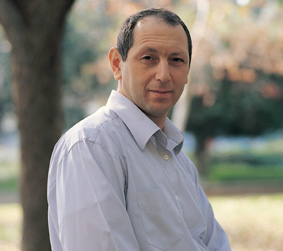Smart. Flexible. Copes well with stress. Adjusts quickly to new situations. Sound like a candidate applying for a demanding job? Indeed, except that the "candidate" is an unusual ceramic material capable of adapting to changing and stressful conditions.
Like discovering that your next-door neighbor, whom you supposed for years to possess average intelligence, is in fact a genius, a common ceramic material has been found to possess a hidden talent. Scientists at the Weizmann Institute, led by Prof. Igor Lubomirsky of the Materials and Interfaces Department, have discovered that under certain conditions, cerium gadolinium oxide behaves more like rubber than a regular ceramic: Much like a squeezed rubber ball, it adjusts to an externally imposed shape but regains its original shape once released from its constraints. The scientists designed a drum-like structure in which a "drumhead" – a thin film of the ceramic less than 1 micron thick – was tethered to a frame. At room temperature, the film was flat and perfectly fit the frame. When heated gradually, rather than buckling, as an average ceramic would, the "smart" ceramic remained steadfastly flat, even when the temperature was raised to 180°C. And when cooled back slowly, it still retained its original shape and showed no signs of cracks.
Instant heating and cooling, however, produced buckling and cracking – just like your run-of-the-mill ceramic. Apparently, the time factor played a crucial role. A rubber ball offers a perfect analogy for the two scenarios: When squeezed relatively slowly, it deforms to adjust to the stress and regains its shape when released. In contrast, upon fast impact – as, for example, when thrown against the floor – the ball bounces without altering its shape.
What mechanism makes the ceramic so "smart" and adjustable? The secret lies in the two types of so-called point defects the material contains: atoms of gadolinium that had been introduced into cerium oxide and vacant spots left where oxygen had been pushed out by the gadolinium atoms. These latter "vacancies" allowed the defects to move about in the material – something like movie viewers changing seats in a half-empty cinema. As the ceramic cools, the loss of energy drives the two types of defects closer together into a more "economical" state, and the material's volume shrinks gradually, without cracking.
Additional materials might possess a similar stress-coping ability, says Lubomirsky. Together with Anna Kossoy of the Materials and Interfaces Department, Dr. Yishay Feldman and Dr. Ellen Wachtel of Weizmann's Chemical Research Support, as well as Prof. Joachim Maier of the Max Planck Institute for Solid State Research in Stuttgart, Germany, he developed the theoretical framework for the ceramic's rubber-like behavior and supported it experimentally.
A material's ability to retain its original shape at all temperatures could be extremely useful, for example, in devices that undergo repetitive warming and cooling, such as fuel cells that convert chemical energy directly to electricity. The clever ceramic could also help in the manufacture of sophisticated microscopic devices that need to perform highly reproducible measurements, such as micro-sensors or miniature pumps.
Prof. Igor Lubomirsky's research is supported by Mr. and Mrs. Yossie Hollander, Israel.
